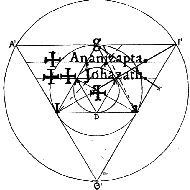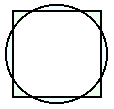- There are stones whose inscriptions begin with the word +ananizapta+ on the two oldest gates of the medieval town wall of Ingolstadt, the Old Feldkirchner Gate from the year 1368 and the former Harder Gate from the year 1373.

- Inscription on the Old Feldkirchner Gate in Ingolstadt (Photo: Dr. Werner Karl)

- Inscription on the former Harder Gate in Ingolstadt (Photo: Stadtarchiv Ingolstadt)
- In 1996 Dr. Werner Karl published a new interpretation of this word.
- The oldest document where Ananizapta is found is a manuscript of Erfurt from the year 1349 (cod. Amplon. Quart Nr. 377).
Dr. Karl found out that the gates of Ingolstadt are the only gates with the word Ananizapta.
He also found the word in the prayer books of the Emperor Maximilian I (Older Prayer book from 1486: 26v; Newer Prayer Book from 1513 which Albrecht Dürer decorated with marginal drawings: 44 fol.34v) and on a bell (beginning of the 15th century) in Strelln in Sachsen (Saxony).
- Dr. Karl`s interpretation is also applicable to other spellings of the word:
- Ananyzapta - Coventry - Ring, 15th century, British Museum
- Ananizzapta - manuscript 418 of the University Library of Graz after 1348
- Ananiszapta - gold ring, 14th century, British Museum
- Ananisapta - great prayer bell of the Ulm Cathedral, 1454
- Ananisabta - on a ring Goethe received in 1794; on a silver chelice of the early 16th century, Victoria and Albert Museum
- The letter z obviously changed into the letter s in the course of time.
- On the stone of the Harder Gate the letter "z" of the inscription has got a little tail.
This made Dr. Karl suppose that the letter z (dragon with the tail of the devil) is the abbreviation of the Greek - latin word zabolus = devil; the letter "s" of the spelling Ananisap(b)ta can be explained by analogy as the abbreviation of satanas = satan.
- Dr. Karl`s theory was confirmed by the "Enchiridion Leonis papae".
- This book is ascribed by tradition to Pope Leo III who is said to have given this "handbook" as a present to Charles the Great.
- In the best print (Mainz, 1633) Johazath is written asymmetrically arranged under Ananizapta.
The whole is surrounded by four crosses and the letters I a g.

- + Anani z apta
- ++ Joha z ath
- According to the medieval way of thinking the devil is the agent of all disorder and confusion (therefore the asymmetrical arrangement).
Dr. Karl thinks that the letters z (zabolus = devil) in Ananizapta and in Johazath are the logical axis which divides the two words into four parts of words.
- These parts of words, however, put into disorder by the devil, are connected to a meaningful order by the stylistic figure of the chiasmus - the name comes from the Greek letter Chi: X = cross = initial letter of the Greek word for Christ: XPISTOS).
- So the parts of words Anani and ath belong together as well as apta and Joha, as the "cross" of Christ crosses (= destroys) the two letters z ("devil"):
- An an i - ath is the abbreviation of
- Anathema anathema Iesus
- "A curse, "a curse on Jesus!" (Epistle of St. Paul to the Corinthians 1/12,3)"
- that means "A curse on the devil!"
- apta - Joha is the abbreviation of
- baptismate Johannis
- "because of/through the baptism of John"
- Dr. Karl thinks that the meaning of the whole formula is:
- Jesus Christ defeated death (the devil)
- by being baptized by John
- and by dying on the cross ("chiasmus").

- Anani-ath and apta-Joha consist of eight letters each.
The number eight is a symbol of the baptism which gives eternal life through the remission of sins (therefore the form of the octagon for baptisteries).
- The letters I a g which surround this formula in the form of an equilateral triangle are a symbol of the secret of the Holy (agia) Trinity.
- Dr. Karl analysed the geometrical structure of the Ananizapta-Johazath-formula:
- The builders of the gates of Ingolstadt probably didn`t know the exact meaning of this formula particularly since they only used its abbreviation (Ananizapta).
But they were certainly aware of its beneficial effect on averting all evil.
- Summary: Kurt Scheuerer, 1999
- Werner Karl,
- Ananizapta - eine geheimnisvolle Inschrift des Mittelalters
- (a mysterious inscription of the Middle Ages),
- Sammelblatt des Historischen Vereins Ingolstadt, 105. Jahrgang, 1996, S.59ff.
- (Collection of articles of the Historical Society of Ingolstadt 105th annual volume 1996, pp. 59-90)
- In German
- Also see:
- Werner Karl, Ananizapta und der Middleham Jewel (Ananizapta and the Middleham Jewel),
- Sammelblatt des Historischen Vereins Ingolstadt, 110. Jahrgang, 2001, S.57 ff.
- (Collection of articles of the Historical Society of Ingolstadt, 110th annual volume, 2001, pp. 57-74).
|

